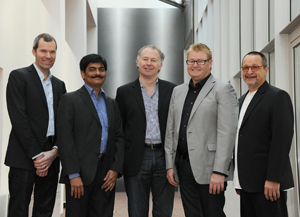Ask an expert

Mal Corboy on his experience judging the 2011 International Design Award
1. How did you feel when you were asked to be an adjudicating panel member at the 2011 International Design Award?
It was a great honour to be given the opportunity to be a judge of the International Design Award. To be considered, you had to submit a CV so the organisers could see what you’ve achieved over your career.
The judging panel was chosen from around the world and it’s fantastic to be the first person from Australasia to be invited to judge the competition.
2. How did you find the experience?
It was an amazing experience to be in a room with four fellow judges who come from all different design backgrounds. Once we started judging and communicating, we likened the experience to music. As designers we all spoke the same language, even though we were from all around the world. We all got on really well and respected each other.
The awards were very professionally run, one of the highlights of my career, I think.
3. How does the competition compare with design awards programs in Australia?
Because it’s on such a different platform — it’s a conceptual award for students — and the amount of entries — there were about 1000 entries from 50 countries this year — it’s difficult to compare the award with design awards programs in Australia.
4. What was the judging process like?
At the start of the process, all of the entries were laid out in a room and each judge was given different coloured post-it notes. We wandered around the room and, if we liked something, we put a post-it on the entry.
As the entries narrowed down, ones without post-its were removed. We went through this process four or five times until the number of entries came down to around 20 and then we had to discuss the merits of each of the projects. We then narrowed the number down to the five winners. This took about one-and-a-half days.
Over the next few months, the judges and I have to head off in different directions to award the prizes. I’ll either be heading to Poland or Toronto to present an award to one of the winners and also give a paper at their university on design.
5. Were there any aspects of the competition that we should apply to similar programs here?
Having the judges in the room together is, I think, a good process. I feel that coming together and discussing the selection of entries that have made it through the first round of judging is important.
If you bring everyone together and discuss the entries, an entry that might look like an obvious winner might have drawbacks that the judges might not have picked up on individually.
6. What are some of the benefits of entering design competitions?
In this particular competition, there are prizes for the top five entries and then a further 50 certificates are given out to the next lot of entrants. Most of these students are hired by large companies and go straight into the workforce from university.
In general, the main thing would be getting your name out there. If I hadn’t entered different awards programs over the past few years, I would’ve have been given this opportunity.
Entering design competitions also allows you to get recognition and respect within the industry.
7. What is your advice for designers who are entering the 2011 KBDi DESIGN20eleven Awards Program?
Keep it simple. The simpler you keep your entry, the further you are going to go through the process. Some people are really in-depth when putting together their entries, but from a judge’s perspective, you really want the information to be very concise.
In fact, one of the winners at the International Design Award submitted an entry that had no text, only two images that explained what the project did.
So, keep it simple, don’t over-complicate and don’t over-clutter.
8. What’s next for Mal Corboy?
We’ve got some exciting prospects in Australia that we’re hoping to have up and running by the end of the year. There’s also a lot of work throughout the year that I’ll be doing as Hettich’s brand ambassador and then basically I’ll just keep doing what I’m doing. And, of course, I’ll be travelling to either Poland or Toronto to hand out the International Design Award to one of the five winners.
Run by Hettich and Rehau, judging for the International Design Award was held 1-2 March at Marta Museum in Herford, Germany. For more information, visit www.internationaldesignaward.com
A striking red staircase has become the symbolic thread connecting two NAB workplaces located 24 kilometres apart, with ...
A new boutique for Les Chocolats de Chloé has brought a burst of colour and childhood wonder to ...
Domed timber roofs, stone cladding and an emphasis on natural materials define Suyian Lodge, a new safari resort ...
Morris Property Group has lodged an application to consolidate three neighbouring commercial sites in the heart of Canberra, ...
With Summer approaching it’s the perfect time to elevate your outdoor living experience with Morsø, the specialist manufacturer ...








